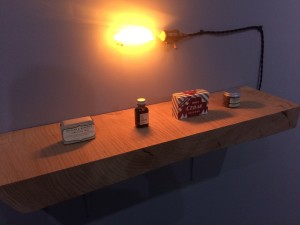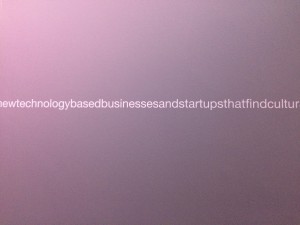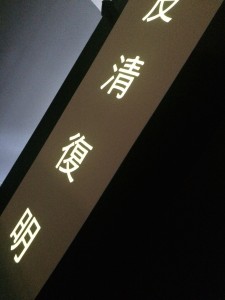TRANSGRESSION/CANTOSPHERE and Acts of Translation
越界/粵界 (TRANSGRESSION/CANTOSPHERE) is an exhibit hosted by Centre A gallery, featuring the collaborative work of Hong Kong Exile (Natalie Tin Yin Gan, Milton Lim and Remy Siu), linguist Zoe Lam, and visual artist Howie Tsu. The work is a celebration of the 粵 Yuht language family, with specific focus on Cantonese: a language under threat in China and Vancouver. This exhibit pushes against Chinese governmental efforts to ban Cantonese from “the airwaves and… from use in the public sector” (Transgression/Cantosphere pamphlet), as well as the gentrification of Chinatown in the name of multiculturalism. Here, the term multiculturalism is replaced by diversity.

Upon entering the small gallery space, one is confronted by a found object: a “Welcome to Historic Chinatown”sign with Chinese characters projected over it that I could not read, but was told by one of the exhibit’s curators meant “Welcome to Chinatown/Tang People’s Street.” The word “historic”is very notably missing from the Cantonese translation, pushing back against the City of Vancouver’s attempts to situate Chinatown in a museum-like, static past. To the side is a mahjong table with sets of headphones sprawled across it. Putting them on, one hears a woman teaching a man a variety of Cantonese proverbs. Stepping around the front wall, another scene unfolds: obscured often in darkness, lights flickering on and off, one sees a quote from the City of Vancouver’s “Chinatown neighbourhood plan and economic revitalization strategy”which urges Chinatown shop keepers to be friendly and to encourage the high tech industry to settle there as a way to revitalize/gentrify the area.

Beneath these words is a wooden shelf, illuminated by a flickering lamp: on the shelf are items like “beard oil”and various woodsy soaps. The curator tells me that the best description he heard of the shelf was as a “lumbersexual longing for muscular Christianity,”pointing to these items as an aggressive and exclusive representation of masculinity, especially for those (male and female) who cannot grow beards at all. Finally, in the darkness is an illuminated screen that produces various Cantonese puns; a list translating them into English is available at the gallery entrance.
The exhibit, for the most part, resists translation. The Cantonese puns in English are no longer puns at all: it is a form that relies completely upon Cantonese homonyms.
While the exhibit pamphlets translate various elements of the exhibit, it is hard to know what each translation refers to without the help of a curator or Cantonese fluency. This brings the idea of a “Cantosphere”home: a location in Vancouver where Cantonese is a privileged mode of expression. This acknowledges Vancouverites who operate in Cantonese, and may find the ubiquity of Vancouver’s English, or Mandarin, highly alienating. This experience is thus a very conscious reversal of those alienating feelings, stressing the need for un-translated Cantonese space in Vancouver. The exhibit as a whole pushes against ideas of Cantonese culture as a site of decay, asserting its right to exist as a dynamic force in Vancouver: promoting a more genuine multiculturalism in which cultures are able to be preserved rather than obliterated or outlawed.
This exhibit provokes a multiplicity of questions about multiculturalism and the gentrification of Vancouver. Its politics of translation evoke the idea of “translator/traitor”: sometimes things should not be translated.
Source: 越界/粵界 (transgression/cantosphere) exhibition pamphlet. 2015. Print.

